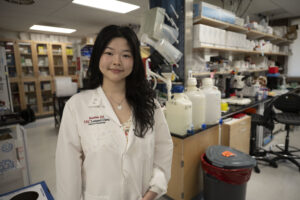
The Gerontological Society of America (GSA)—the nation’s largest interdisciplinary organization devoted to the field of aging—has chosen Sean P. Curran, PhD, of the USC Leonard Davis School of Gerontology as the 2014 recipient of the Nathan Shock New Investigator Award.
The distinguished honor is given for outstanding contributions to new knowledge about aging through basic biological research. It was established in 1986 to honor Nathan Shock, PhD, a founding member of GSA and pioneer in gerontological research at the National Institutes of Health.
The award presentation will take place at GSA’s 66th Annual Scientific Meeting, which will be held November 5-9, 2014 in Washington, DC. This conference is organized to foster interdisciplinary collaboration among researchers, educators, and practitioners who specialize in the study of the aging process.
At USC, Curran is an assistant professor of biogerontology in the Davis School of Gerontology; of molecular and computational biology in the Dornsife College of Letters, Arts, and Sciences; and of biochemistry and molecular biology in the Keck School of Medicine.
His research focuses on molecular, genetic and biochemical approaches to identifying evolutionarily conserved mechanisms that regulate cellular and organism survival and longevity. He is combining genetic, molecular biology, and biochemical techniques and approaches to understanding the vital roles of metabolism in normal aging and aging pathology. He also is combining studies in worms with mammalian cell structure and mouse studies to validate the universality of his findings.
In February 2014, Curran published a widely discussed article in Cell Metabolism that explored a novel cellular pathway, alh-6, in C. elegans. The study demonstrated the worm’s ability to age successfully on various diets when the pathway was active; however, when the pathway was inactive due to a mutation, the worms would age prematurely when fed a diet outside of a specific regimen.
“We have identified a novel pathway that facilitates successful aging on multiple diets. We call this dietary adaptation, or the ability to use multiple types of diets,” Curran explained. “We believe this is just one of many types of gene/diet pairs out there. This pathway is highly conserved even in humans and perhaps is similarly utilized to facilitate adaptation to the diverse types of food we eat.”
Curran said receiving the Shock Award was an incredible honor, and he thanked the GSA for the recognition of his work.
“Previous Shock awardees are leaders in the field and researchers I look up to,” Curran said. “I am humbled to be included in this group.”
Curran has received national attention from the Ellison Medical Foundation, the American Federation for Aging Research, and the Glenn Foundation for Medical Research as well as earned a Mellon Mentoring Award for his work with USC students.
Press release courtesy of the Gerontological Society of America. Additional reporting by Beth Newcomb.
Congratulations Class of 2014! The largest class in the USC Leonard Davis School of Gerontology’s history graduated today. Bringing together faculty, staff and students, the graduation program also included the largest number of award presentations by the University to students from the Davis School.
“I am amazed by these students,” said Dean Pinchas Cohen who delivered the welcoming address and closing remarks. “They are reinventing aging as we know it and I am positive that they will have an important role to play in all of our futures as they advance in their careers.”
The USC Leonard Davis School has always been a tight-knit group which provides both faculty and student the opportunity to really enjoy the experience more personally as their academic careers flourish. Among the 70 graduates were 5 new PhD students as well as 4 new recognized Doctoral Affiliates. It was during the PhD hooding ceremony that Drs. Susan Enguídanos, Tara Gruenewald, Eileen Crimmins, Valter Longo, Bob Knight, and Mara Mather were able to convey the connection that faculty have with their students.
“I’m sorry; I will be talking for over a minute even though we’re not supposed too. I just have so many good things to say and one minute just isn’t enough time. I feel a bit selfish saying I’m sad to see Joohong leave us, but we’re very proud of her and we’ll miss her,” said Dr. Gruenewald as she delivered her heartfelt send off.
After honoring the accomplishments of our graduating class, Dean Cohen closed out our commencement with some reassuring words and a reminder that we are all part of an ever growing Trojan family. “I encourage you to remain closely in touch with the school as you pursue your goals and further your careers; after all, we are united by a shared dream–the dream of a better and more vibrant aging experience for all. Congratulations and Fight On!”
——————–
Heinz Osterburg Prize – Morgan Levine
Order of Troy – Jacqueline Dion
Renaissance Scholar – Jacqueline Dion
Discovery Scholar Prize Finalists – Brandon Glousman, Kyrstin Harris, Joshua Man, Elaine Roh, Kezia Rusli
Discovery Scholar Prize Recipient – Brandon Glousman
McNair Scholar – Nicole Marcione
Gerontology Minors – Elizabeth Breiter, Sarah Fell, Sara Lanier, Aaron Mejia, Kimberly Morton, Rachel Piperno, Lauren Salas Mationg, Maurice Turner, Sidney Zahabizadeh
Bachelor of Science in Human Development and Aging – Asmaa Albaroudi, Tiffany Chu, Marie Danielian, Jessica Davis, Jacqueline Dion, Brandon Glousman, Jessica Gonzalez, Megan Greaney, Raphi Hambartzhumian, Kyrstin Harris, Natalie Innocenzi, April Jordan, Christine Karapetian, Susan Kazandjian, Joshua Man, Nicole Martin, Myra Mendoza, Nicholas Persinger, Elaine Roh, Kezia Rusli, Mary Stepanyan, Jae Yoon Yi
Bachelor of Science in Lifespan Health – Nicole Marcione
Graduate Certificate in Gerontology – Crystal Baham, Robin Drubin, Aubrie Hills, Cheryl Lampkin, Jennifer Martin, Lana Perry, Maria Yefimova
Master of Long Term Care Administration – Heather Diaz
Master of Arts in Gerontology – Susan Adams, Donna Anderson, Nathan Bowman-Johnston, Selim Ciftci, Jordan DeVera, Susan Fair Clark, Ileana Gavina, Hannah Godwin, Heather Gulas, James Hill, Ann Hollander, Jacqueline Hurt, Cynthia Hutchins, Janine Katsikas, Kelley Le, Karen Love, Michelle Matter, Christie Miller, Christina Muzzy, Jenna Patterson, Larry Perkins, Sandra Rachon, Lisa Saldana, Nishad Sathe, Loreen Trevino, Jelisa Turner, Brenda Vazquez, Melissa Weaver, Anna Whitlock, Logan Wimer, Robert Worthen, Walter Zuhosky
Master of Aging Services Management – Michelle Akahoshi, Mateen Ansari, Rochelle Balaban, Jennifer Brewer, Catherine Dilley, Joyce Dirkes Chavez, Elizabeth Donnell, Travis Freed, Kimberly Henderson, Lisa Herring, Melissa Itzkowitz, Yolanda Lawler, Ruth Le, Catherine Lee, Scott McAulay, Meagan McClellan, Carlena McKnight, Lu Meng, Sam Moghaddamfar, Nell Moton Kapple, Calli Peacock, Donna Phillips, Jon Schwartz, Jessica Taylor, Paul Wanson, Darin Weidauer
Master of Science in Gerontology – Crystal Bettenhausen-Bubulka, Sahar Edalati, Kristina Field, Virginia Hazarian, Craig Hung, Ani Kolangian, Angelica Kutnerian, Cera Meintzer, Pamela Maree, Ramirez, Catherine Salvino, DeVonet Taylor, Jeannette Torres, Tavin Vasuntarapiwat, Kim Vu, Eve Wettstein, Carin May Wong, Anna Woo
Doctor of Philosophy in Gerontology – Alexis Coulourides Kogan, Jeffery Laguna, Joohong Min, Nicholas Pisca, Felicia Wheaton
Recognition of Affiliated Doctorate – Chia-Wei Cheng, Philip Sayegh, Matthew Sutherland, Alexandra Ycaza






